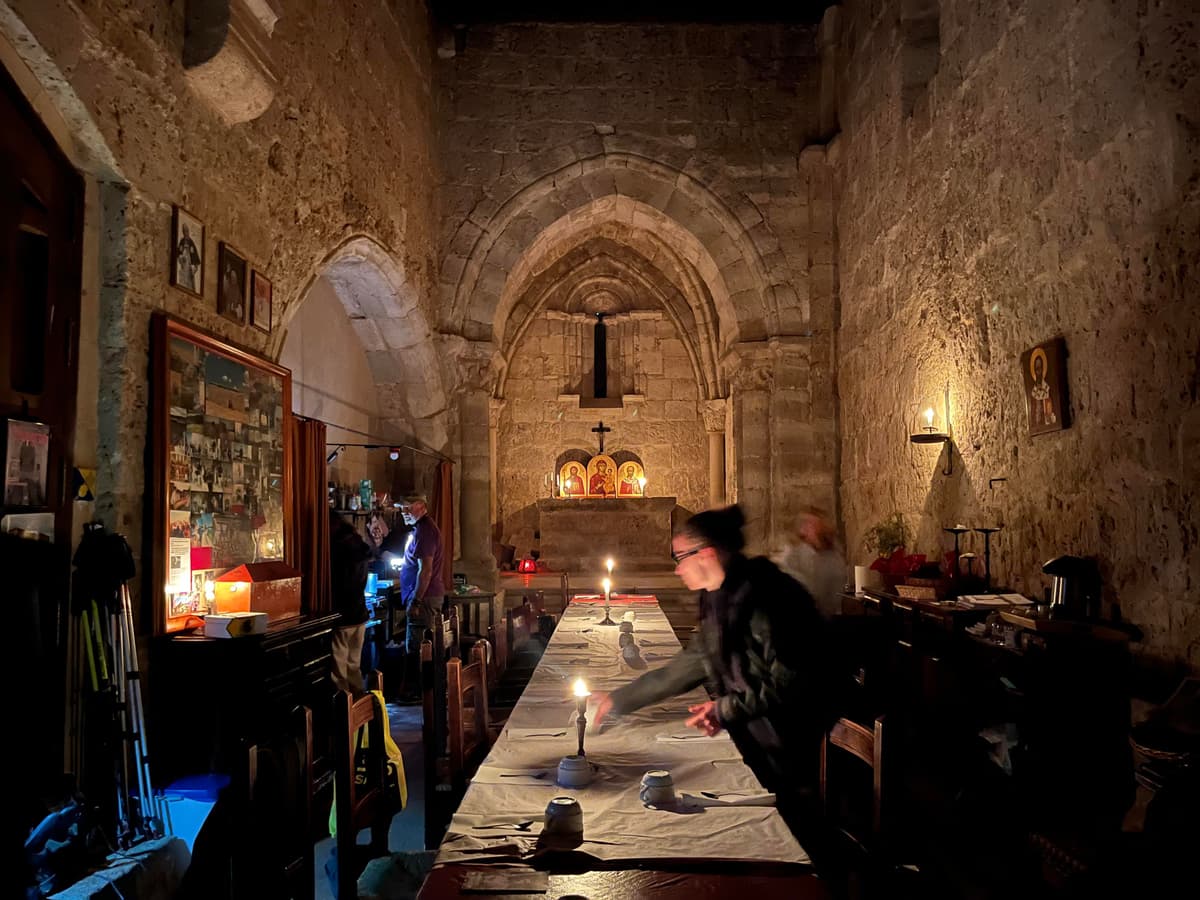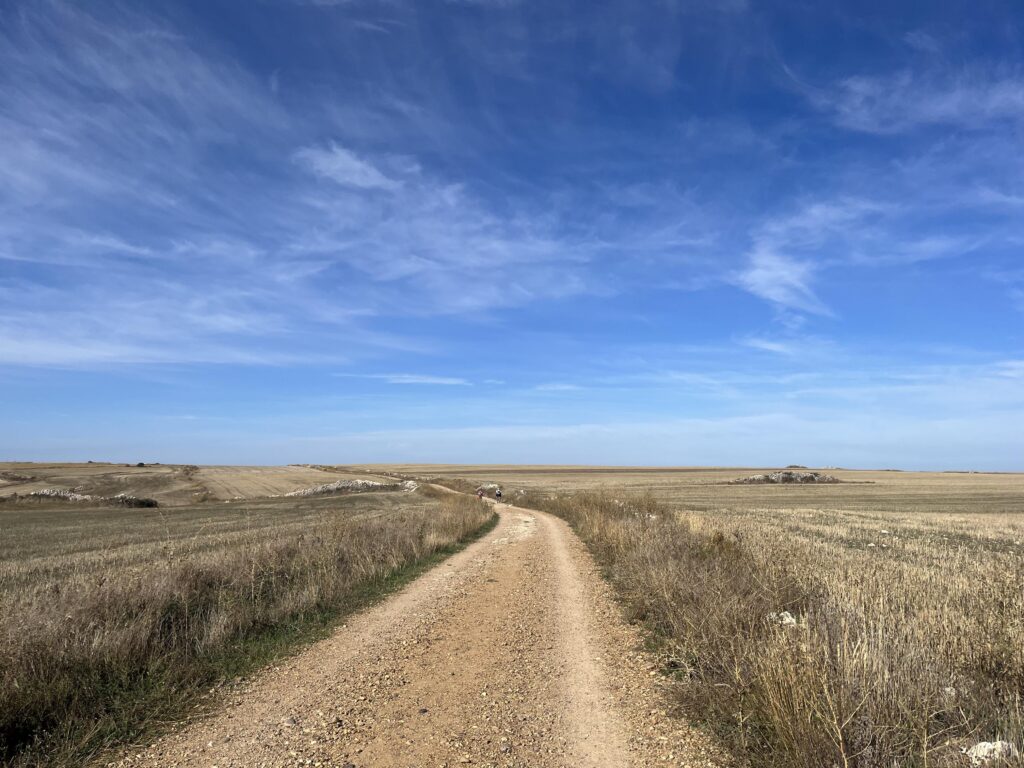The Camino Diaries, Week Three: On the Desolate Meseta, a Little Slice of Heaven
Outside the village of Itero de la Vega, the outline of the Ermita de San Nicolas appears like a mirage floating on the dense fog, welcoming the wet, cold, and weary travelers — whose feet are about to be washed.

On my second day crossing the dreaded Meseta, the long stretch of dry desolate fields between Burgos and Leon in central Spain, the rain starts. After a score of warm, sunny days, the temperature drops into the 50s, and the wind howls across the plain.
My “waterproof” boots are soaked through within an hour and with each step they emit a little squelch. It is miserable, and I have 18 miles to go for the day. I now know why many on the Camino Frances skip this portion of the 500-mile walk to Santiago Compostela by hopping a bus that whisks them to more appealing surroundings.
Just outside of Itero de la Vega, the outline of the Ermita de San Nicolas appears like a mirage floating on the dense fog. The two Italian hospitaleros, the volunteers that run the hostel, usher me and my two companions out of the damp cold and into a small stone building lit only by candlelight. They hand us cups of hot coffee. In the corner sits a shivering older man wrapped in blankets— he’s been sick for days, staying under the care of the Italians until he is well enough to walk again.
The Ermita is one of many unique albergues, or guesthouses, that welcome pilgrims on this centuries-old path. In 1991, an Italian man named Paolo restored the ruins of an old church to provide a shelter for pilgrims on the Camino. It has no electricity, and is manned by volunteers. Guests, who sleep in one of 12 bunks in its loft, are asked only to donate what they can for their bed and board.
Before dinner, an ancient bell rings inside the building summoning the guests to have their feet washed and blessed by the volunteers, mimicking Jesus’s washing of his apostles’ feet. It is no quick task. By nightfall, the stone floor is littered with pilgrims, illuminated by candlelight, swaddled in thick wool blankets.
These donation-only albergues, known as donativos, are not only a godsend for pilgrims on a budget, but they also reflect the truest spirit of the Camino — an unwavering hospitality. Twenty people, some of whom had to sleep on the floor that night, sit around a large candlelit table for a dinner of spaghetti with vegetables, fresh salad, red wine, and honeydew melon with cinnamon. It is the best meal of my month-long walk.
After dinner, we all sit cross-legged in front of the altar for a bedtime ceremony. A female hospitalero leads us humming in unison, eyes closed, for ten minutes. She says the tradition prevents snoring. To my utter surprise, it turns out to be my first night on the Camino without snorers in the dormitory disrupting everyone’s exhausted slumber.

Unfortunately, not all donativos on the Camino are as special or delightful as the Ermita. Some offer just mats on the floor, or cots riddled with bed bugs. In my experience, however, they are always worth giving a chance.
Along with the donativos, the Camino has private albergues, and so-called municipals run by the village in which they sit. Municipals are typically cheap, first-come first-serve, and fairly basic. They often lack heat, but usually have a kitchen for pilgrims to prepare their own meals and cost between eight and ten euros a night.
Private, for-profit albergues also line the route, and are more expensive but much more comfortable than the budget options. Often, they are run by former pilgrims or people passionate about the Camino itself and average around between 12 euros and 15 euros a night for a hot meal and a bed in a dormitory.
A particular standout among the private albergues is Albergue Verde in Hospital de Órbigo. I learn of the hostel via word of mouth, not having seen mention of it in any online forums or Camino guides. When I arrive one afternoon, one of the hospitaleros is on a ladder picking fruits for the next day’s breakfast. He greets me by handing me an overripe fig, split open and oozing rich fleshy pulp. It was the best thing I’ve ever eaten.
The Verde property itself is gorgeous — an impressive vegetable garden, multiple hammocks, and a separate building housing a yoga studio with free classes nightly at 6. Three small dogs lounge in the sun and bark at every passerby.
Before dinner, the volunteers working at this albergue sing a song for the day’s arrivals. The lyrics roughly translate to a repeat of the refrain, “We see the universe in this food, thank you.” Dinner itself is a small miracle: thick salted slices of fresh heirloom tomato, giant servings of vegetarian paella, roasted pepper spread, and vegan apple cake for dessert.
The 30 or so guests sit at a long extended picnic table in the backyard, one that, come morning, is laid out with a breakfast of toast, figs, yogurt, and instant coffee. We are asked only for a donation for each of the meals.
Although the Meseta and the Camino itself is grueling and dull at times, the nights at these one-of-a-kind albergues make up for the day’s monotony. Those opting to skip the Meseta are missing out. The most memorable experiences on the walk are the unexpected ones, those not mentioned in the many guidebooks about the Camino to Santiago.

